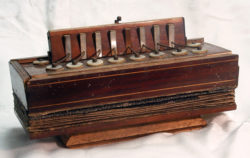Accordion Making
The diatonic button accordion is a prominent and distinguishing feature of Cajun music, first imported to Louisiana from Europe in the late nineteenth century by German Jewish immigrants.

Courtesy of A World of Accordions Museum
8-key bisonoric diatonic accordion. Henry Doktorski (Photographer)
The diatonic button accordion is the prominent and distinguishing instrument of Cajun music, first imported to Louisiana from Europe in the late nineteenth century by German Jewish immigrants. People of color apparently were among the first to adapt the new instrument in Louisiana. Several sources suggest that an Africanized Louisiana accordion aesthetic developed, including a nineteenth-century daguerreotype of a black man holding a button accordion, lithographs and wood cuttings depicting people of color performing on various accordion types, and the highly syncopated style in which Cajun musicians perform. World War II made these instruments difficult to acquire, since many German accordion factories were either bombed or within Russian control after the war. By the 1950s, Sidney Brown of Lake Charles had become one of the leaders in local accordion production, influencing a whole generation of devotees including Marc Savoy, perhaps the state’s most famous contemporary accordion maker.
A Brief History of the Accordion in Cajun Music
The first imported accordions, made in the keys of A and F, effectively rendered the earliest accordions soloists by default. During the first half of the twentieth century, however, importers offered Monarch, Sterling, Eagle, and Hohner accordions tuned to C and D, keys more suitable for ensemble performance in southern Louisiana. The instrument had clearly gained a foothold in Cajun and Creole music by the time small acoustic ensembles recorded the first accordion-based arrangements on phonograph. In 1928, Joe Falcon and Cléoma Breaux’s “Lafayette” featured Falcon performing the song’s melody on a diatonic button accordion. Similarly, the first rural Afro-Creole recordings, predating the emergence of zydeco, began in 1929 with “La Valse de la Prison,” featuring accordionist Kirby Riley accompanying fiddler Douglas Bellard. The instrument lost prominence during the Great Depression, when Cajun swing ensembles emphasized string band arrangements. It reemerged, however, when accordion-based ensembles once again dominated Cajun dance halls and recording studios after World War II, and local entrepreneurs began designing and fabricating their own accordions.
Accordion Makers
Louisiana accordion maker Larry Miller suggested that the first Cajun accordion builders found their inspiration in eastern Texas, where thousands of Cajuns relocated to work in the petroleum and shipbuilding industries between 1901 and the 1950s. Miller maintained that John J. Mrnustik, an Eastern European immigrant who ran a music store in Houston, was the first person to make accordions along the western edge of the Gulf Coast. Just across the border in Lake Charles, Sidney Brown began refurbishing old accordions; he eventually tried building his own.
A teenager and budding accordionist, Marc Savoy played one of Brown’s accordions and felt compelled to build his own. “By the fall of 1965,” remembers Savoy, “I had pretty much taken up my father’s outdoor kitchen with my accordion building hobby. Accordion parts were scattered all over the place” On November 19, 1966, Savoy opened the Savoy Music Center in Eunice, which provided him with a storefront for his fledgling business. His “Acadian” brand instruments quickly became recognized as some of the best diatonic accordions in the world. Over time, other accordion makers began building instruments from their homes, each with different brand names: Mouton (Shine Mouton), Bon Tee Cajun (Larry Miller), Martin (Junior Martin), and Falcon (Randy Falcon), among others.
Accordion construction is labor intensive, although many components are fabricated off site. The bellows and reeds that produce the characteristic sound, for instance, are usually ordered from Italy. The wooden housings for the reeds and fingerboard, however, are handcrafted from a variety of woods, including spruce, maple, and cypress. Older master craftsmen now apprentice a new generation of accordion makers. Today dozens of local accordion manufacturers operate in Louisiana and eastern Texas, taking orders from around the world and selling their wares often for more than $2,000 per accordion.
